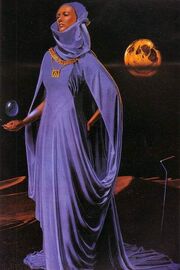
|
This article or section refers to elements from the Dune Encyclopedia. There are separate pages for this subject as it appears in the other canons, the reasons for this are explained here |

Rogue Zensunni -Fanart
Zensunni was a religious belief system prominent with many cultures spread across the Known Universe, especially those descended from disadvantaged and enslaved peoples.
History[]
They were followers of a schismatic sect that broke away from the teachings of Maometh about 1381 BG. Most scholars name Ali Ben Ohashi as leader of the original schism but there is some evidence that Ohashi may have been merely the male spokesman for his second wife, Nisai[1].
In accordance with their devotion, the Zensunni believed that they owed no allegiance to any secular government and the sect found most of its followers in those peoples already disposed to self-government; on Terra the Zensunni represented a small fraction (in 1572 AG there were less than 50,000) and they preferred nomadic isolated life in places such as the Sahara Desert.
Their migration started in 2800 AG when Siridar Baron of Terra, Charles Mikarrol, forcefully sent two million Zensunni to Poritrin, to comply with Elrood V's order who wished to populate the planet.
During their stay on Poritrin Zensunni developed understanding of neural physiology and this understanding led to the distrans; Zensunni never relied on thinking machines. Over several generations, on Rossak, under the guidance of their Sayyadina they rolled back 16,000 years of language change. On Harmonthep they invented the first paracompass and on Ishia they developed the stilltent. The Zensunni had been used as laborers of many different types.
Zensunni homeworld was considered to be legendary Nilotic al-Ourouba.
Later, the Zensunni predisposition was manipulated by the Bene Gesserit, via their Missionaria Protectiva arm and Panoplia Propheticus strategy, for their own political objectives. Their last station, Arrakis, was of particular interest in this regard. The exclusivity of the critical Spice Melange on the planet made the resident Fremen, staunch followers of Zensunni, of natural interest to the Bene Gesserit. It is theorized an early contact with the Bene Gesserit which would explain because of the interrelation between the BG and the Fremen Motherhood.
The emergence of the powerful Paul Atreides, and his adoption of Fremen ways, gave Zensunni beliefs a dramatic new popularity. After his ascension to Emperor Paul embarked on a ferocious jihad that brought great violence and turmoil. The stark contrast of these actions vis-à-vis pacifist Zensunni beliefs was not lost on some of the faithful.
The Preacher sought to reawaken the relapsed Fremen to their Zensunni heritage
Core Beliefs[]
Little is known of the evolution of the Zensunni faith. What is beyond doubt is that the Zensunni belief was an amalgamation of two ancient religions: Sunni Islam and Zen Buddhism. The Zensunni religion is noted chiefly for its emphasis on the mystical and a reversion to "the ways of the fathers". The Zensunni mixed heritage of Zen and Sunni traditions became mingled with other deep-strata convictions during their long quest.
Its underlying purpose was to answer the sunnah — the ten thousand religious questions posed by the Shari-a — with mystical understanding, and not with the more usual rational approaches
Their religion was severe in the extreme. It demanded close obedience to an authority figure who must have literally had the power of life and death over his subjects which in Fremen religion materialized on the naib.
As a faith, Zensunni has beliefs such as the existence of Auliya as God's handmaiden and the ilm and figh.
A cult of mystics practiced siayla "Light of Truth", held annually among the Zensunni to discuss the progress made toward their religious goals during a year.
Their interest in messianic psychology, for instance, was augmented by the Missionaria Protectiva's long-range planning. "Hearthside supersititions" were accumulated in non-desert surroundings. The addictive spice-water ecology entered the Fremen society on Arrakis. So it is not easy to be certain what parts of their theology (Urn), ritual and behavioral assumptions were as ancient as their Terran origins.
Zensunni beliefs parallel the cultural patterns of the OCB: a model calls of a Creation for the benefit of Humankind, the Fall of Man, and a tempestuous battle at some predetermined but unspecified End, between Good and Evil.
The Zensunni were monotheists, believing in one God (Buddallah) who does not interfere in day-today events but determines the overall pattern of temporal affairs, and who is merciful and compassionate rather than vengeful. Since the later Fremen prohibited tombs, this indicates that a spiritual rather than bodily afterlife was large in their anticipations, with water at the core of the dreams of paradise (yet Leto II's satisfactory description of the Paradise to Come implies that physical senses would be rekindled after death). Pardot Kynes' plans for the terraforming of Arrakis certainly harmonized with the Fremen's ultimate hopes. On their way to Paradise, the Fremen expected a grand devastation, the Typhoon Wind at the end.
The ancient model of specific Beginning and Ending, when thrived, was neither peculiar nor consistent and all-inclusive: Each system, separate satellite, and sometimes different communication groups or "sects" of "all-believers" on a single satellite, believed that they were the Chosen; its population alone would survive the climax-battle, and reinforced their community through prejudice against strangers (the "unwashed" or the "infidel") who did not accept their metaphysics and rituals- This tendency to splinter instead of embrace is noteworthy because, a heritage of persecution and enslavement and flight can compress a culture of believers into patient fanatics. Defeat and exile were transformed by the faithful Wanderers into hajr and eventually into vengeful triumph — jihad — where the true believers struck back and justified the long-nurtured reciprocity of faith in the Creator and Creator's faith in The People.
See Also[]
Zensunnis[]
Writings[]
- Zensunni Codex
- Shah-Nama
- Koan Answers
- Ohashi
- Hui-Neng
- Tao
